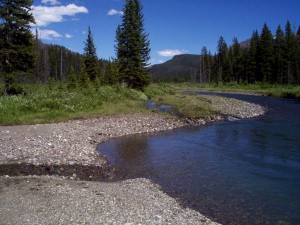
U.S. Department of the Interior
U.S. Geological Survey
By Gregory K. Boughton
Prepared as part of the NATIONAL WATER-QUALITY ASSESSMENT PROGRAM
The full report is available only in Adobe Acrobat® PDF format, 5.57mb. The PDF file displays high-resolution, printable pages best viewed with Acrobat Reader 4.0 or above. If you don't already have this free viewing software, or need to upgrade your version, download it here. Users with visual disabilities may wish to visit the Adobe Systems accessibility website, which offers conversion tools and information to help make PDF files accessible.
| Acid drainage from historic mining activities has affected the water quality and aquatic biota of Soda Butte Creek upstream of Yellowstone National Park. Numerous investigations focusing on metals contamination have been conducted in the Soda Butte Creek basin, but interpretations of how metals contamination is currently impacting Soda Butte Creek differ greatly. A retrospective analysis of previous research on metal loading in Soda Butte Creek was completed to provide summaries of studies pertinent to metal loading in Soda Butte Creek and to identify data gaps warranting further investigation. |  |
Identification and quantification of the sources of metal loading to Soda Butte Creek was recognized as a significant data gap. The McLaren Mine tailings impoundment and mill site has long been identified as a source of metals but its contribution relative to the total metal load entering Yellowstone National Park was unknown. A tracer-injection and synoptic-sampling study was designed to determine metal loads upstream of Yellowstone National Park.
A tracer-injection and synoptic-sampling study was conducted on an 8,511-meter reach of Soda Butte Creek from upstream of the McLaren Mine tailings impoundment and mill site downstream to the Yellowstone National Park boundary in August 1999. Synoptic-sampling sites were selected to divide the creek into discrete segments. A lithium bromide tracer was injected continuously into Soda Butte Creek for 24.5 hours. Downstream dilution of the tracer and current-meter measurements were used to calculate the stream discharge. Stream discharge values, combined with constituent concentrations obtained by synoptic sampling, were used to quantify constituent loading in each segment of Soda Butte Creek.
Loads were calculated for dissolved calcium, silica, and sulfate, as well as for dissolved and total-recoverable iron, aluminum, and manganese. Loads were not calculated for cadmium, copper, lead, and zinc because these elements were infrequently detected in mainstem synoptic samples. All of these elements were detected at high concentrations in the seeps draining the McLaren Mine tailings impoundment. The lack of detection of these elements in the downstream mainstem synoptic samples is probably because of sorption (coprecipitation and adsorption) to metal colloids in the stream.
Most of the metal load that entered Soda Butte Creek was contributed by the inflows draining the McLaren Mine tailings impoundment (between 505 meters and 760 meters downstream from the tracer-injection site), Republic Creek (1,859 meters), and Unnamed Tributary (8,267 meters). Results indicate that treatment or removal of the McLaren Mine tailings impoundment would greatly reduce metal loading in Soda Butte Creek upstream of Yellowstone National Park. However, removing only that single source may not reduce metal loads to acceptable levels. The sources of metal loading in Republic Creek and Unnamed Tributary merit further investigation.
Send questions or comments about this report to the Wyoming District Webmaster Team.
| AccessibilityFOIAPrivacyPolicies and Notices | |
 |
|